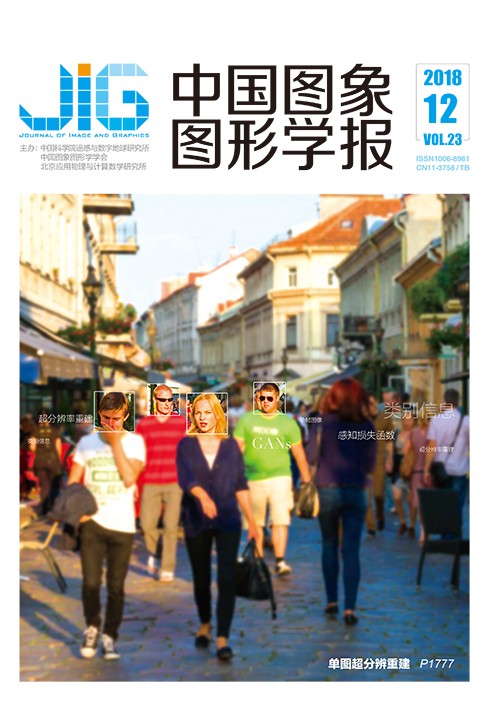
快速鲁棒核空间模糊聚类分割
摘 要
目的 传统模糊C-均值聚类应用于图像分割仅考虑像素本身的聚类问题,无法克服噪声干扰对图像分割结果的影响,不利于受到噪声干扰的工业图像、医学影像和高分遥感影像等进行目标提取、识别和解译。嵌入像素空间邻域信息或局部信息的鲁棒模糊C-均值聚类分割算法是近年来图像分割理论研究中的热点课题。为此,针对现有的鲁棒核空间模糊聚类算法非常耗时且抑制噪声能力弱、不适合强噪声干扰下大幅面图像快速分割等问题,提出一种快速鲁棒核空间模糊聚类分割算法。方法 利用待分割图像中像素邻域的灰度信息和空间位置等信息构建线性加权滤波图像,对其进行鲁棒核空间模糊聚类。为了进一步提高算法实时性,引入当前聚类像素与其邻域像素均值所对应的2维直方图信息,构造一种基于2维直方图的鲁棒核空间模糊聚类快速分割最优化数学模型,采用拉格朗日乘子法获得图像分割的像素聚类迭代表达式。结果 对大幅面图像添加一定强度的高斯、椒盐以及混合噪声,以及未加噪标准图像的分割测试结果表明,本文算法比基于邻域空间约束的核模糊C-均值聚类等算法的峰值信噪比至少提高1.5 dB,误分率降低约5%,聚类性能评价的划分系数提高约10%,运行速度比核模糊C-均值聚类和基于邻域空间约束的鲁棒核模糊C-均值聚类算法至少提高30%,与1维直方图核空间模糊C-均值聚类算法具有相当的时间开销,所得分割结果具有较好的主观视觉效果。结论 通过理论分析和实验验证,本文算法相比现有空间邻域信息约束的鲁棒核空间模糊聚类等算法具有更强的抗噪鲁棒性、更优的分割性能和实时性,对大幅面遥感、医学等影像快速解译具有积极的促进作用,能更好地满足实时性要求较高场合的图像分割需要。
关键词
Fast robust kernel-based fuzzy C-means clustering segmentation
Wu Qiping, Wu Chengmao(School of Electronic Engineering, Xi'an University of Posts and Telecommunications, Xi'an 710121, China) Abstract
Objective In existing image segmentation theories and methods, the fuzzy clustering segmentation method has been widely studied and applied in image segmentation and object detection in images with intrinsic fuzziness and uncertainty. Fuzzy C-means clustering and its related improvement is a typical unsupervised clustering learning method, which has become an important tool in solving problems in image processing, machine vision, and remote sensing image interpretation. Many relevant scholars, local and abroad, have paid high attention to this research field for a long time. The classical fuzzy C-means clustering applied in image segmentation has only considered the clustering problem of pixels and cannot overcome the influence of noise on image segmentation results and thus cannot meet the requirements for target extraction, recognition, and interpretation of industrial, medical, and high-resolution remote sensing images. Hence, a robust fuzzy C-means clustering segmentation algorithm that is embedded in pixel spatial neighborhood or local information is a popular topic in image segmentation theory in recent years. The existing robust kernel-based fuzzy C-means clustering segmentation algorithms cannot meet the requirement of fast and robust segmentation of large images with strong interferences, such as Gaussian, salt-and-pepper, and mixed noise due to the large time cost and weak ability to suppress the aforementioned noise. Hence, a fast robust kernel-based fuzzy C-means clustering segmentation algorithm, which is based on a two-dimensional histogram, is proposed in view of pixel clustering accumulation. Method The linear weighted filtering image is first obtained by combining the gray and spatial location information of neighboring pixels with other related information in the segmenting gray image. The weighted filtering image is segmented by the existing robust kernel-based fuzzy C-means clustering to obtain positive segmentation quality and strong robustness against Gaussian, salt-and-pepper, and mixed noise. Second, to improve the operational efficiency of the robust fuzzy clustering segmentation algorithm in further segmenting large images, the two-dimensional histogram between the current clustered pixel and mean value of its neighborhood pixels is introduced into the existing robust kernel-based fuzzy C-means clustering method with spatial information. The two-dimensional histogram-based fuzzy clustering optimization mathematical model of the robust kernel-based fuzzy C-means clustering method is constructed in view of pixel clustering accumulation. In summary, the iterative expression of the gray level robust fuzzy clustering segmentation algorithm to segment image is rapidly deduced by the Lagrange multiplier method to solute the new optimization model of the robust kernel-based fuzzy clustering segmentation method embedded in the two-dimensional histogram of the weighted filtered image. Meanwhile, a fast robust kernel-based fuzzy C-means clustering segmentation in the two-dimensional histogram is designed to implement image segmentation. Result Segmentation results of the noiseless standard medical and large remote sensing images that are interrupted by Gaussian, salt-and-pepper, and mixed noise, show that the proposed fast algorithm in the two-dimensional histogram can obtain better segmentation performance than those of the existing robust kernel-based fuzzy C-means and other kernel-based fuzzy clustering segmentation algorithms. In detail, the proposed fast robust kernel-based fuzzy clustering segmentation algorithm has increased the peak signal-to-noise ratio by nearly 1.5 dB, reduced at least 5% of the misclassification rate, and increased approximately 10% of the partition coefficient compared with the existing robust kernel-based fuzzy clustering segmentation algorithms with spatial neighborhood information. In the meantime, the method can reduce the computational complexity to a considerable extent, and the running speed of the proposed robust kernel-based fuzzy clustering segmentation algorithm is similar to that of the classical kernel-based fuzzy C-means clustering segmentation method based on a one-dimensional histogram. Furthermore, the result of the proposed fast robust kernel-based fuzzy C-means clustering segmentation algorithm has better segmentation effects than those of the existing kernel-based fuzzy C-means clustering segmentation algorithms from the perspective of human visual perception. Conclusion Compared with the existing robust kernel-based fuzzy clustering segmentation algorithm, which is based on spatial constraints of neighborhood information, the kernel-based fuzzy C-means and classical fuzzy clustering segmentation algorithms and the proposed algorithm with spatial neighborhood formation not only have stronger ability against noise but has also improved segmentation performance and real time. Meanwhile, it has a positive effect on rapid interpretation of images, such as large high resolution remote sensing and medical images. The proposed algorithm can meet the requirements of large remote sensing and medical image segmentation with high real-time demands.
Keywords
image segmentation kernel function fuzzy clustering linear weighted image two-dimension histogram robustness clustering validity
|



 中国图象图形学报 │ 京ICP备05080539号-4 │ 本系统由
中国图象图形学报 │ 京ICP备05080539号-4 │ 本系统由